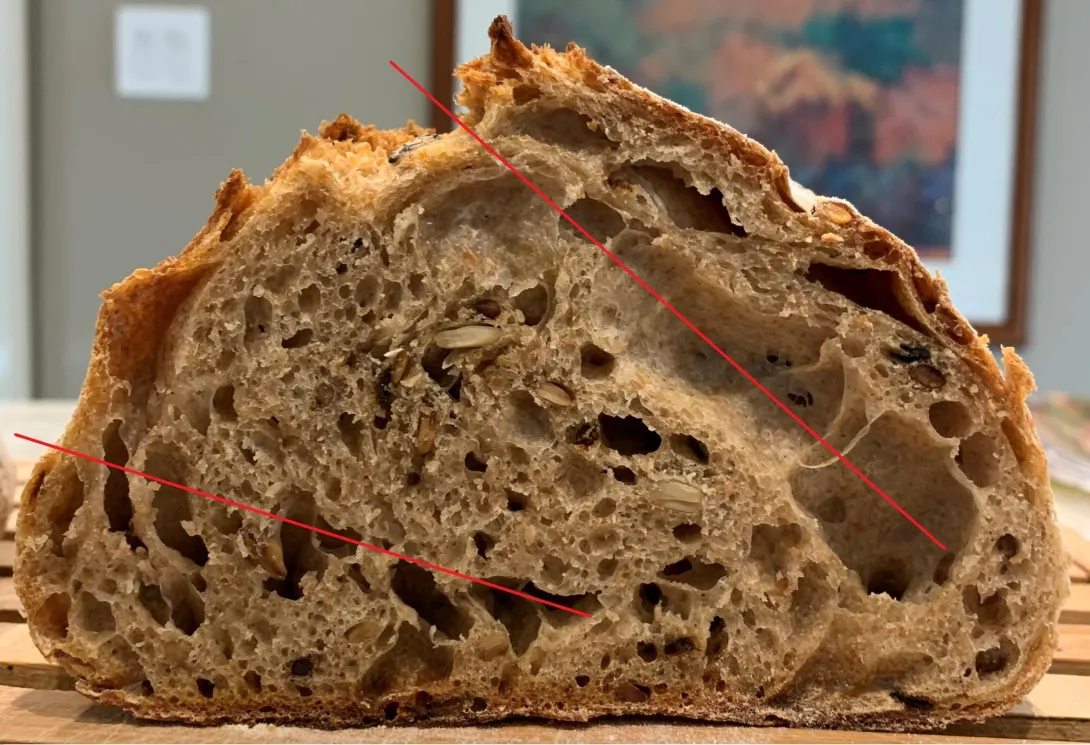
I shaped this bread as a cylinder,folding the dough toward me a few times. There are clear lines of air bubbles that I assume are caused by air trapped by those folds. Is there a way to avoid that from happening? if the folding movement is trapping the air, later pressing on the dough will probably not get rid of the air, so I think the deficiency is in the shaping technique itself. Thanks in advance for the help!
If you haven't watched Hamelman shape up his loaves, watch this video. You won't get more of an expert lesson than this imho.
https://youtu.be/PmxDKuGLWuE
I'll also add that your loaf looks great imho.
When I look at many of these crumbs and crusts, I've gone to viewing them as I do trees. When you look at a tree, you'll notice it never makes an aesthetic mistake. Ever.
As long as the bread tastes good and people enjoy it, there are no "mistakes" or misshapen loaves. Yes someone may tell you it's got mistakes, but relative to what?
My .02.
Bread Lee
This happened to me once when I added a bit of moisture partway through the knead. My theory is that if a bit of extra moisture gets trapped on the surface while you are folding, that layer retains its shape (though it gets laminated inside). The yeast have an easier time growing in that layer and also the last to die off during the last bloom in the oven. So you get more gas formation in that region. It also happened once when the counter was a bit wet.
Maybe this isn't what happened exactly with your loaf, but it helps to reason in terms of gas formation.
I agree, bubbles that big are probably from folding the dough. The Hamelman video shows him patting it down before he shapes to get rid of them. He goes so fast though. I found this one for high hydration doughs that shows a batard shaping - first part is the pre-shape, final shaping starts around 5:30-6:00 into the video. He uses the heel of his hand to seal the seam each roll, also pressing lightly to deflate large bubbles. https://www.youtube.com/watch?v=vEG1BjWroT0
Play that video at 1/2 speed. Hehe.
I've been wondering that about my own recent bakes as well. I wonder if my shaping is causing large holes in my finished loaves as I have had those as well. During shaping I try to dust off any excess flour, but don't really pat down the dough. I've always thought that we are so careful with not degasing the dough during fermentation so that we should continue to try not to degas during shaping. But perhaps some patting down would be helpful to reduce the large holes. Thanks for starting this topic.
Benny
I think access flour on the shaping surface can very well be the reason for the bubbles. Since the shaping process folds this flour into the dough, the flour can create separation between the dough layers and prevent them to merge into each other. I probably had too much dusting flour and it is very visible that the bubbles are arranged according to the folding lines . However, I am not sure how to prevent that from happening since if the dough is wet and sticky, it is really hard to work without dusting flour as the dough will attach itself to the surface.
Thanks!
When I've used too much dusting flour and not dusted it off the dough before folding it, I have usually been able to see a line of white flour in the baked crumb. I don't recall ever seeing large holes associated with these lines of flour though.
Benny
I know how desirable many bakers consider large holes, BUT it is best if you pop extra large bubbles that appear during the stretch & folds and other such dough manipulations. Lamination traps lots of air and the large pockets (bubbles) of air should be deflated. For deep pockets, a large needle or even an ice pick is good.
Keep in mind, I am not a fan of huge holes. But even if I were, large pockets of air and even CO2 bubbles at the surface should be deflated.
Dan